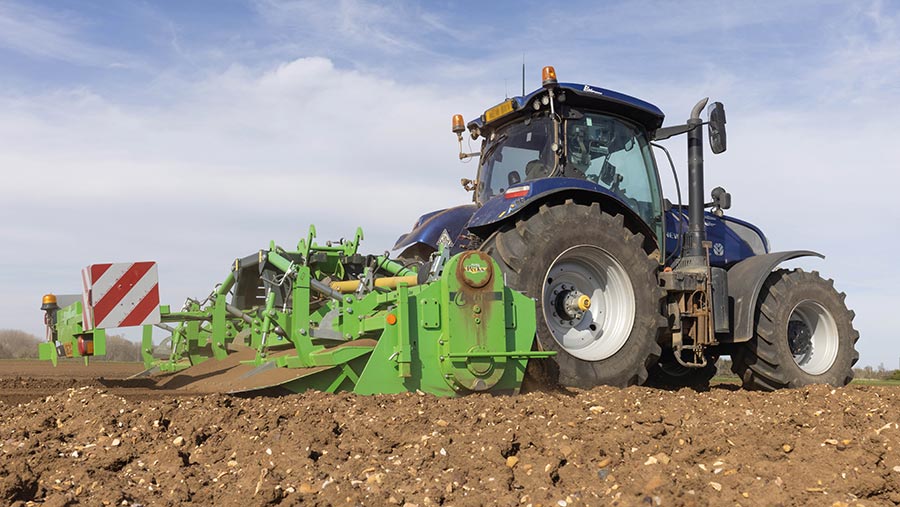4 tips for successful potato establishment this spring
 © Tim Scrivener
© Tim Scrivener Good establishment is critical in potatoes, setting the crop up for optimal yield for the chosen market.
Norfolk-based Prime Agriculture potato agronomist Alistair Neill offers some tips on how growers can give their spud crops the best start this spring.
About the author

Alistair Neill has spent 10 years in the potato Industry, predominantly at Greenvale & Produce Solutions, and joined Prime Agriculture in 2021 with the ambition to explore some new avenues in the potato industry.
1. Be patient with cultivations
We have had some drying weather during February in East Anglia, but ground is still wet in places and there haven’t been any moves to start groundwork ahead of potatoes just yet.
Patience is key before commencing with cultivations and seed-bed preparation, as compaction is one of the biggest restrictors of potato yield.
See also: How to grow potatoes using minimal tillage
It is important to check soil moisture throughout the profile to ensure no smearing occurs at depth, which can create a barrier for rooting, leading to poor water and nutrient uptake.
Also important is not overcultivating, as destoning too deep and too fine can result in structural issues such as slumping, as well as needlessly burning diesel.
Research over many years has shown that many potato producers are cultivating too intensively. Moving to a shallower depth from very deep work had little impact on yield and quality.
Savings in fuel and labour can also be significant, which are welcome in the current inflationary climate.
2. Source quality seed
With uncertainty surrounding contracts and crop area, very little 2023 seed is on-farm. It is expected that a large proportion will be delivered in a very short space of time.
This will put pressure on planning and logistics ahead of planting, so it’s important to remain focused on getting the basics right.
Sourcing good-quality, healthy seed should be a priority. Potato margins are under more pressure than ever and starting off with sub-optimal seed quality will compromise yield before you’ve even begun.
Having a close relationship with trusted suppliers is increasingly important in getting top seed. There has been a trend over the past few years to reduce field generations of seed stocks, which helps deliver better quality to the farm gate.
Try and get seed delivered ahead of time and where possible, take the time to check quality as soon as it arrives on farm.
Seed should be de-bagged into boxes on arrival and put into a store with adequate temperature control and ventilation, as bags are only intended for temporary storage during transit.
If it cannot be de-bagged, it is best to store with as much space around the seed as possible.
Good seed storage will ensure sprouting is controlled and that seed remains dry – free moisture is enemy number one and can enable disease to develop rapidly, particularly blackleg.
Ideally, all seed should be sampled, washed up and checked for signs of diseases such as black scurf, which is caused by rhizoctonia solani.
Black scurf on the tuber surface can be easy to spot, but if no symptoms are seen with the naked eye, it can be worth checking eyes with a magnifying glass for any rhizoctonia hyphae that may be lurking. Testing is also an option where there is time.
When it comes to deciding on treatment, I like to consider disease presence on tubers, variety susceptibility, field history of potatoes and pests such as free-living nematode (FLN), planting date and conditions at planting, as well as the market the crop is growing for.
There are liquid fungicide options pre-planting available, but this poses a challenge for most growers with handling of the seed and application of the products, which leads most to powder treatment at planting.
In-furrow treatments can also help protect young plants from soil-borne inoculum, with options including Amistar (azoxystrobin) and Allstar (fluxapyroxad).
3. Use the correct seed rate
An appropriate seed rate – or seed spacing – for the variety and market specification you are growing for is essential to maximising marketable yield.
If growing for pre-pack markets, baker content will be important and oversize tubers (>85mm) will be penalised. For salads, tuber numbers are the aim and seed rates need to be much higher.
Seed rates can also be manipulated to bring harvest dates forward, with lower planting density giving plants more space and resources to reach market specification much faster.
Tools such as Crop4Sight’s seed module can help calculate all these variables, including the seed’s chronological age – which influences stem numbers – to give an appropriate seed rate for each seed lot and planting date.
Certain varieties, such as Jelly, are very sensitive to chronological age and it’s important that this is factored into calculations.
Once you have entered the 50% emergence date of the seed lot and the intended planting date of the ware crop, the system’s algorithms take care of that for you, rather than having to try and calculate it all yourself.
One client I work with, who gets a lot of value out of the seed module, grows about 70ha of Jelly. Last year this was produced from three seed stocks and each seed stock had two or three size grades.
Historically, with standard seed-rate tables I would have provided the grower with six or seven seed rates for his programme.
With Crop4Sight, we might be presented with 30 or 40 different rates, depending on stock, size, and chronological age.
It may sound complicated, but the system is simple to use and allows you to constantly adjust seed rate over time, taking into consideration any change of plans, or delays due to weather or breakdowns.
Making the adjustments on modern potato planting equipment is relatively straightforward and Crop4Sight allows me to have all the information to hand for the planter operator.
This ensures each field and seed lot is planted at the correct spacing.
4. Planting depth
Planting at a correct and consistent depth is another decision often overlooked. It is vital for rapid emergence to get the crop up and expanding ground cover to maximise season length.
Consistent depth also enables even emergence, which is critical for crop uniformity in canopy and tuber size.
An even crop is significantly easier to manage in relation to irrigation and desiccation than an uneven one and will ultimately optimise returns.
Historically, growers like to be at 20cm for main crop potatoes to allay concerns over greening.
Research has shown that reducing to 12.7-15cm had no effect on greening. Gradually growers have listened and have moved shallower, which has helped speed of emergence with no negative effect on quality.
